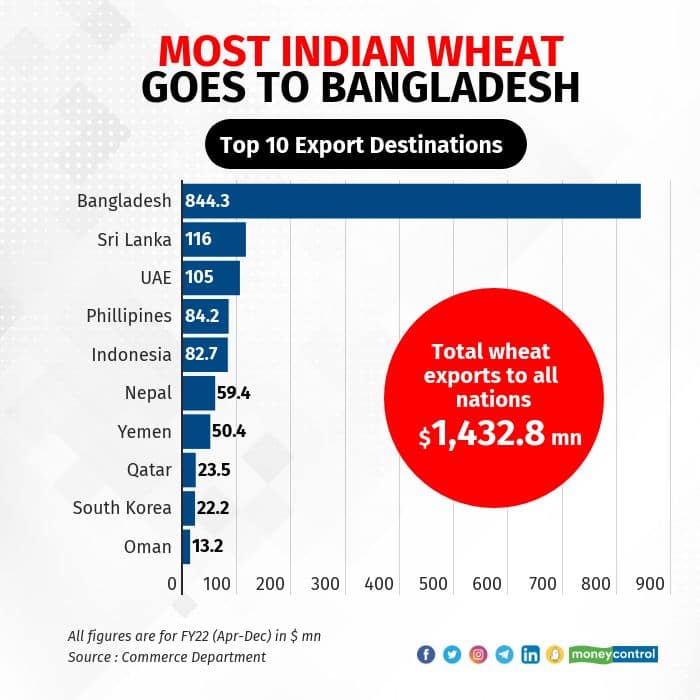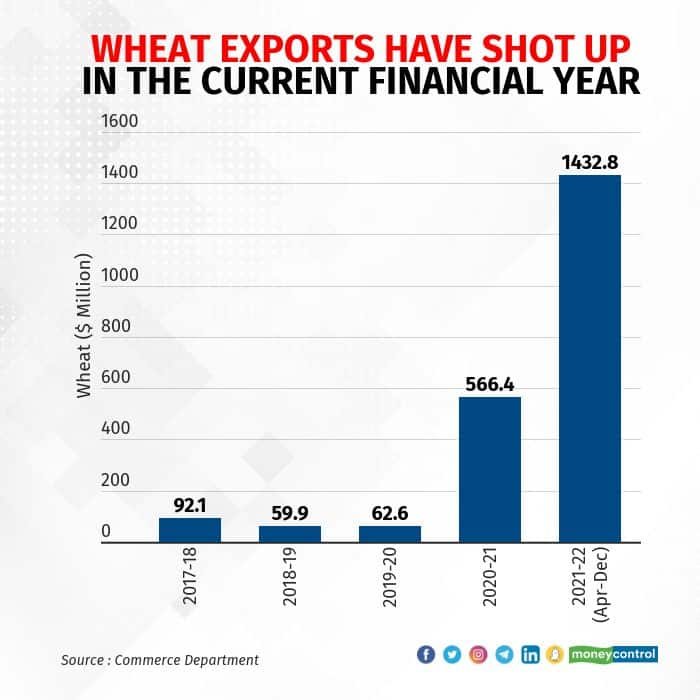With Russia invading Ukraine, grain exports from the country, known as the breadbasket of Europe, have already stopped. But even though India maintains a surplus of wheat, it may not be in a position to exploit the opportunity to export more grains to the European market, they stressed.
Apart from the lack of regulatory approvals needed to sell agricultural products in Europe, the availability of Russian wheat also stands in the way. Despite mounting sanctions against Russia, western powers have till now kept agricultural trade outside its purview.
However, officials said India may see an uptick in wheat exports to neighbouring Bangladesh, which has been steadily buying more wheat from India. India’s exports have historically been to its immediate neighbours in the subcontinent and the Gulf region, in some cases. Indian wheat has slowly begun to be exported to distant destinations such as Indonesia, the Philippines and South Korea in recent years due to changing trading patterns.
But it overwhelmingly still goes to just one country. Bangladesh bought 60 percent of India’s wheat allowed for imports in the current financial year, followed by Sri Lanka (8.1 percent), and the United Arab Emirates (7.3 percent).

Sixty percent of India’s wheat exports head to Bangladesh
Bangladesh only real market
A largely rice-producing nation, demand for imported wheat in Bangladesh has skyrocketed in recent years, recently making it the fifth-largest wheat importer in the world. While the country had been a regular buyer of Ukrainian wheat till 2014, it had since switched to Russian wheat to save costs.
However, this changed earlier this year when Bangladesh announced it would step up wheat purchases from Ukraine again to make up for any shortfall in supplies from Russia, which had announced plans to impose a higher export tax on the grain from March 1, 2022.
As of 2020-21, data from Bangladesh Bank shows India remained the largest source of wheat for Bangladesh. Wheat from India made up 23.9 percent of total wheat imports by the country, followed by Canada (22.8 percent), Russia (20.7 percent) and Ukraine (17.1 percent).
“With wheat supplies from Russia drying up and shipments from Russia still under regulatory haze, prices have already gone up to record levels in Bangladesh. It is now almost certain that more wheat will be sourced from India in the near future,” a senior diplomatic official from the Bangladesh Embassy said.
In the first three quarters of the current financial year (2021-22), India has already exported 29.6 lakh tonnes of wheat to Bangladesh, up from 11.9 lakh tonnes in 2020-21, official data shows.
 Wheat exports have continued to rise fast
Wheat exports have continued to rise fast
Wheat shipments rising
After remaining stagnant for three years, India’s wheat exports have risen fast since FY21, buoyed by bumper harvests and active export promotion. In the ongoing financial year, exports have crossed $1.4 billion.
“India accounts for less than 1 percent in world wheat exports. However, its share has increased from 0.14 percent in 2016 to 0.54 percent in 2020,” a commerce department official said. This has been made possible by the Agricultural Products Exports Development Authority aggressively marketing exports in new markets through business-to-business exhibitions and initiating campaigns with the active involvement of Indian embassies, he added.
India’s wheat exports have always been volatile, and subject to fluctuating domestic demand and the crop cycle. However, wheat exports had hit a high of $1.34 billion in FY14. Subsequently, it had slowly reduced to $160.8 million in FY16, after which exports reduced to a trickle.
The latest pickup since last year has been due to the burgeoning central stockpile of wheat, which has grown as a result of aggressive procurement and consecutive bumper harvests. The Food Corporation of India’s (FCI) total combined stockpile of wheat rose to a record 603 lakh tonnes in July 2021. This has now come down to 282.7 lakh tonnes as of February 2022, FCI data shows.
Global scenario
According to the United Nations Food and Agricultural Organisation, in 2019, after China (133.6 million tonnes) and India (103.6 million tonnes), Russia was the third-largest wheat producer globally (74.5 million tonnes) while Ukraine ranked seventh (28.4 million tonnes). However, large domestic demand ensured that the majority of the crop in India and China is used to feed the local populace.
Source : Money Control







